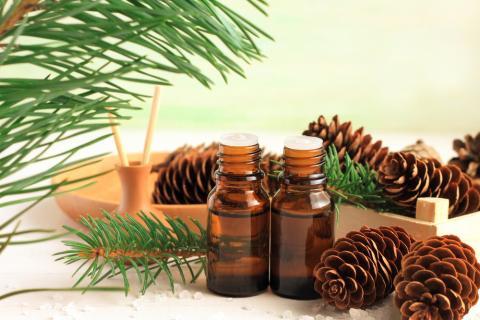
Fir is one of the quintessential scents of the season, known for its foresty, fresh, and somewhat sweet notes. For those of us who live and hike in the mountains, or for anyone who’s had a Christmas tree, the scent of fir is unmistakable. There are over 50 types of delightfully scented fir in the northern hemisphere, and the leaves, twigs, and cones are all rich in aromatics.
Fir trees have been used for many centuries to celebrate winter festivals. Evergreens were symbolic, during the darkest months of the year, of the coming spring and summer. Firs and other evergreens were also representative of everlasting life. Fir boughs used to be hung above entryways for protection against witches, evil spirits, and the like. (It’s interesting how plants used in this way tend to be strongly antimicrobial. A story for another time…)
Aside from its association with winter celebrations, fir is a simply great scent to have around during the darker months, when folks may struggle with the seasonal blues as the light diminishes. Fir is also helpful for anxiety and tension as the holidays approach. That said, fir is just fine to use any time of the year. Fir’s energizing scent is great for sluggishness, and aromatherapists will even rub diluted fir oil over the low back to support the adrenal glands, those little hat-shaped glands atop the kidneys that mediate our stress responses.
Folks familiar with essential oils know that some oils may promote either relaxation or alertness. These seemingly contradictory actions are a result in part of the chemistry of the oil. Fir, for instance, has essential oil components like limonene, pinene, and borneol that have calming or stimulating (or both!) effects. Fir may even help you settle down after staring at a computer screen, something that may be handy for those of us glued to the screen daily for work. An interesting study suggests that fir’s effects may also depend on how it’s actually inhaled. Specifically, research on a Korean species of fir found that its aroma was either more calming or more stimulating depending on whether it was inhaled through both nostrils or just one nostril. Cool, huh? Apparently, the sense of smell differs between the two nostrils. Something to geek out on when you have some spare time, as I imagine that this applies to other oils as well.
Some fir species have traditionally been used for wound healing and reducing inflammation. Fir has also been used for respiratory support, and the oil contains components (such as the aforementioned pinene) with known respiratory benefits. Fir preparations were popular topically as a rub for aches and pains. The chemical makeup of fir essential oil is such that it oxidizes quickly, making it a potential skin irritant. Fir is rich in essential oil components known as monoterpenes so the oil oxidizes pretty quickly. This makes fir a potential skin irritant, so don’t use old oil topically and, as with any oil, always dilute it before putting it on the skin. To make your fir last longer before going off, stick it in the fridge. Once the bottle’s been open for a year, relegate it to your cleaning supplies, since it will no longer smell as good and may not be great for use on the skin by that point.
One last note: Fir, believe it or not, is great for blending into perfumes. It’s generally considered a middle note on the high-middle-base note “musical scale” that is often used for blending. It blends really well with citrus, lavender, frankincense, vetiver, juniper, and many other oils. (Actually, all of these would smell pretty good together as long as you use just a bit of vetiver…)
Additional reading
https://www.aromaweb.com/essential-oils/fir-needle-oil.asp
Keville, K & M Green (2009) Aromatherapy: A complete guide to the healing art. Crossing Press, Berkeley, CA.








